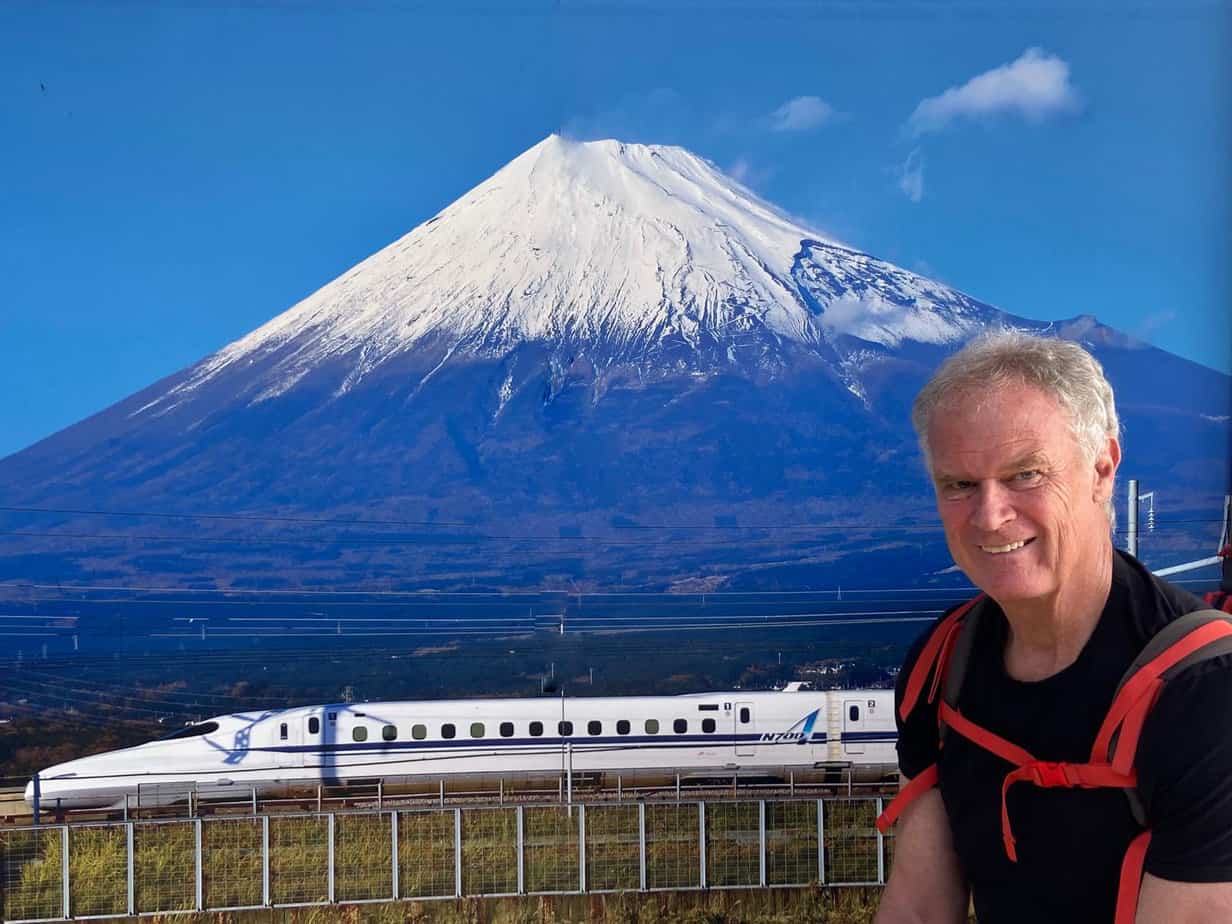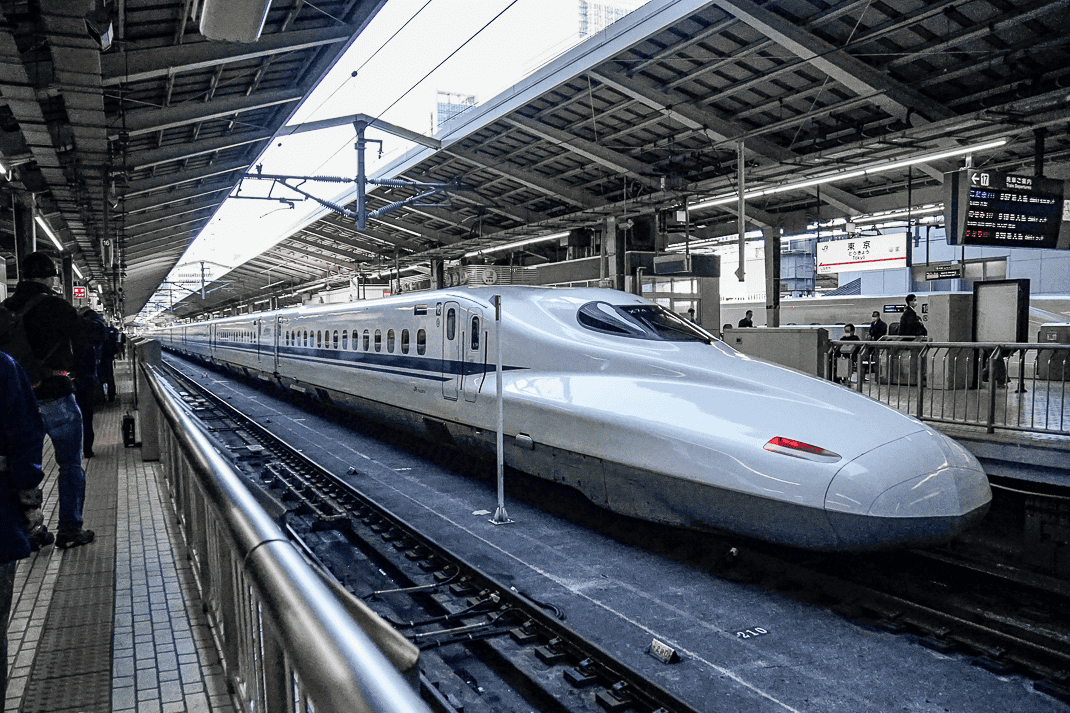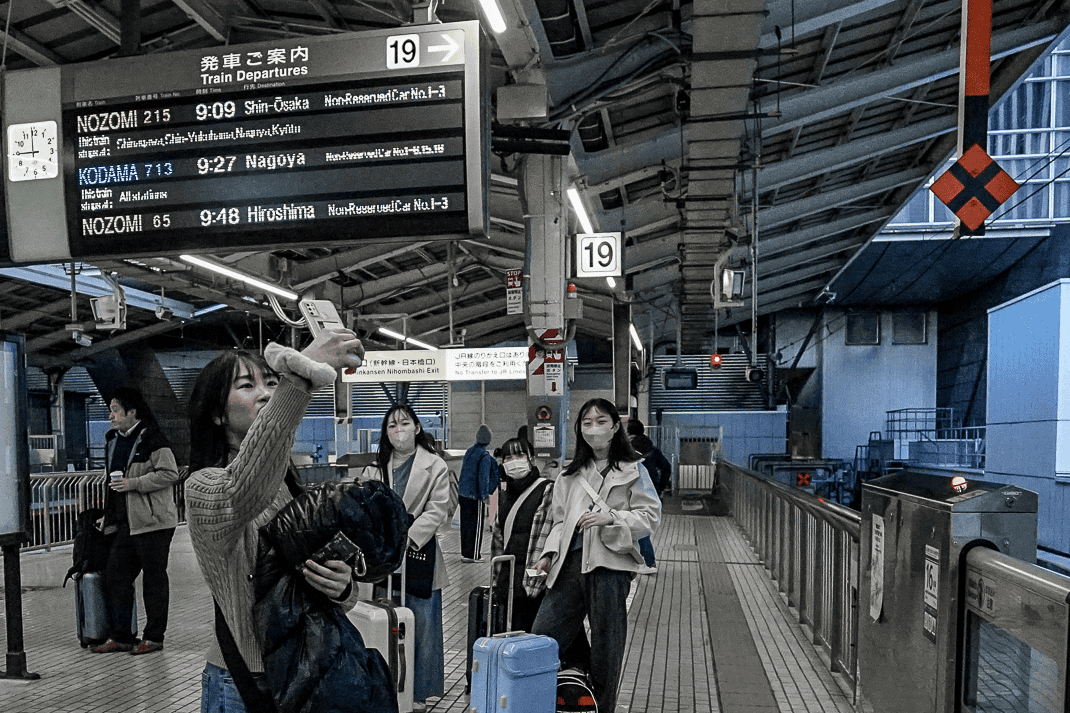Japan’s bullet train puts travel in the fast (200 mph) lane

(This is the second of a series of blogs on Japan and Shanghai.)
TOKYO – How fast is 200 mph (320 kilometers per hour)? Fast enough to make entire mountains disappear from view in seconds. Fast enough to travel across Japan in about two hours. Fast enough to make anyplace in a country a day trip.
For decades I’d heard about the Shinkansen, Japan’s bullet train. It was the epitome of Japanese efficiency and technological skill, along with fuel-efficient cars and eating noodles with chopsticks. I adore train travel. It’s the ultimate way to see a country in the most relaxed mode. I wanted to see Japan on one of the world’s most famous trains.
During our week-long trip to Japan last week, I booked round-trip tickets on the bullet train to and from Tokyo and Kyoto. How efficient is the bullet train? That route doesn’t require the train hitting 200 mph the entire trip, but it did cover the 280 miles in a little more than two hours. How long does Japan’s local trains take?
About eight hours. With four to six transfers.
Japan train stations
While it took us only about two hours to reach Kyoto, it took us about that long to find the damn train in Tokyo. Japan’s train stations in its major cities are enormous. They look like space stations with dozens of tracks on numerous platforms, connected by long corridors lined with everything from fine restaurants to convenient stores.

Much of the signage is bilingual, but finding the right train and platform requires time, patience and a complete lack of claustrophobia. The train stations are packed.
Passengers are highly advised to arrive at least an hour before your train. We arrived 24 hours before. We did a recon mission at Tokyo Station where its confusing collection of escalators, color-coded train indicators and flashing schedule boards are more intimidating than any airport I’ve seen.
However, Japan is as efficient as you’ve heard. Information booths are sprinkled throughout the station manned by kind, smiling people with passable English. We climbed one escalator, walked down a 100-meter corridor, climbed another escalator and found our track.

Bullet train platforms are curiosities themselves. I’ve never seen public transportation with Baskin-Robbins vending machines. It even had a convenience store where I bought a pretty bottle covered in green leaves thinking it was apple juice. It was instead filled by that vile swill I can not comprehend how anyone can drink.
Tea.
Each platform has a glass-walled smoking area. I stuck my head inside the packed room and it was like burying my head into a pile of volcanic ash. Yet Japan has the world’s third-highest life expectancy at 84 years. Something can be said for slow food and fast trains.

The journey
When our train eased into the station, it even looked fast. Snow white and sleek, the front of the train stretches to a rounded point, just like a bullet. Its wrap-around windshield makes it look as if it’s wearing hip sunglasses.
The driver came out wearing a sharp navy blue suit and cap. He nodded to his identically dressed colleague as he took his place for our trip to Kyoto. The train cars are nothing fancy: five seats across with an aisle in the middle. But the leg room was like any first-class train I’ve ever ridden.

I reclined my seat way back, stretched my legs and looked out the window to experience 200 mph. Bullet trains get up to speed quickly. As we sped out of the massive Tokyo metro area, the comfort of the train wasn’t matched by the beauty of the Tokyo-Kyoto route. I knew Japan was a vertical country but I was shocked at how little green I saw.
Business parks had few trees. Forget lawns. I saw a few patches in children’s playgrounds. Even the numerous golf driving ranges we passed had no grass. When we finally reached the countryside, the train hit 200 mph. Scenery was just a blur. Low-rise apartment buildings, retail businesses, villages flew by me like a shuffled deck of cards.
Then came the highlight of the trip I’d heard so much about.

About 50 miles west of Tokyo, rising above the flat plain like an ice cream cone, stood Mt. Fuji. The 12,388-foot (3,776-meter) mountain can be climbed on a 14-hour hike in one day or overnight in one of the huts along the way.
Still snowcapped, it truly was something out of a Japanese tapestry. But at 200 mph, we didn’t see it for long.
The Shinkansen has more scenic routes. In fact, it covers 1,834 miles (2,951 kilometers) of lines and is the mode of public transportation in Japan. The popular routes connecting Tokyo with Osaka and Nagoya carry 159 million passengers a year. In peak hours on peak routes, 16 trains leave per hour with 16 carriages carrying 1,323 passengers plus standing room. Only three minutes separates the trains.
Tracks stretch from Kagoshima-Chuo in the far south to Hakodate-Hokuto on the south end of Hokkaido, Japan’s northernmost island. Plans are under construction for a line farther north to Sapporo.

The history
Despite all its modern trappings, from the sleek lines to the Swiss-watch efficiency, the Shinkansen is 60 years old. In fact, the idea surfaced in 1939. The first fantasy was to build a train with a top speed of 120 mph (200 kph) all the way to Beijing through a tunnel to Korea with an eventual connection to the Trans-Siberian Railway.
They scrapped that lunacy in 1943 when they sobered up and Japan started taking a beating in World War II.
They abandoned plans for a high-speed train as they recovered from the war. By the mid-1950s, however, Japan’s main rail lines were reaching full capacity. In 1957, Japan introduced the 3000 series SE Romancecar which hit a record 90 mph (145 kph). Japanese engineers thought they could go faster.
Facing a government that felt rail transport couldn’t compete with freeways and airplanes making huge strides around the world, Shinji Sogo, president of the Japanese National Railways, insisted on pursuing rail greatness.
In 1958, the government relented. It gave approval and procured an $80 million loan from the U.S. to help cover the initial cost of 400 billion yen. It began service with the popular Tokyo-Kobe route, known as the Tokaido line, on Oct. 1, 1964, in time for the Tokyo Olympics.
The popularity was massive. The bullet train cut the Tokyo-Osaka route from 6 hours, 40 minutes to four hours. By 1965 it cut the time to 3 hours, 10 minutes. Today it takes 2 ½ hours.
By 1967, 100 million passengers rode the bullet train. In 1976, the total reached 1 billion.
It is not the fastest train in the world. The Shanghai Maglev in China travels 286 mph (460 kph) and covers the 19 miles (30 kilometers) from Shanghai’s Pudong Airport to the city center in an eye-watering 7 ½ minutes. The Shinkansen is the fifth-fastest in the world.
The fastest I’d ever ridden was Italo, Italy’s high-end trains that go 186 mph (300 kph).
How to buy
Big travel tip: Do not do what I did. Do not reserve online. Use only the online time schedule. It’s outrageously expensive and with the plethora of trains going every few minutes, there is little reason to reserve ahead of time. I’d been told by seasoned travelers to Japan and former residents to get a JRail Pass. You get unlimited travel for €315 for a week or €503 for two.
However, we were only traveling to Kyoto and back. I was told to reserve a seat ahead of time. This is Japan’s peak tourist season with the cherry blossoms allegedly in bloom. You don’t want to stand the entire trip.
So I did. However, reserving online included an outrageous €110 service charge. It brought two round-trip tickets to €556. We could fly from Rome to Istanbul round trip for a little more than half of that. Neither one of our trains was filled. A train left for Kyoto about every 10 minutes.
I went to the ticket machine to see how much our tickets would’ve cost if we bought the day before we departed. They were only €85 each one way. That’s a total of €340. In other words, it cost me more than €200 more to reserve online. Don’t do it.
But do take the Shinkansen. It gives you more time to smell the cherry blossoms.
(Coming Tuesday: Kyoto.)


April 5, 2024 @ 10:58 pm
Thanks for the fun narrative. We took the Shinkansen after a bus trip to the Mt. Fuji area and one of the most impressive moments was when a bullet train flew by as we were waiting at the station. An odd hissing noise as it approached was quickly followed by what felt like a white jet plane on rails zooming by much faster than I could snap a photo of it.
We got off at Shinjuku Station and it was just as you described, which is like a vast underground city.
What a place!
April 7, 2024 @ 11:41 am
I wish I’d seen that. I was never at a station where the bullet train didn’t stop. I saw them from a distance but they hadn’t hit top speed yet. I didn’t include this in the story but they’ve never had a single death from a train incident. Once in the ’90s a train derailed in the snow but miraculously, no one was hurt. However, they’ve had suicides. They have suicide fences at all stations but they can’t stop people from hopping on a track in the countryside. Can you imagine getting hit by one of those going 200 mph?
April 6, 2024 @ 11:44 am
This is a very timely and useful post for me. I’m going to Japan for 6 weeks in the Fall (for the maple leaves) to celebrate my 70th and I’ve read a ton about the Japanese public transport system(s) in preparation, but until your post I had not seen anything about the plusses of taking the Shinkansen without a reservation. So thanks for that!
April 7, 2024 @ 11:38 am
Glad I could help. Have some flexibility on your departures. There are tons of trains every day going everywhere. Just in case, one gets filled — and apparently they do occasionally — be able to delay your trip a few minutes. Just buy your ticket the day before departure. Shinkansen also has a very helpful information counter that answers all your questions. There will be a line but it moves quickly.